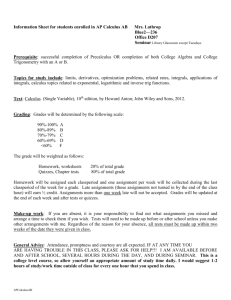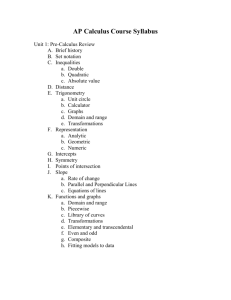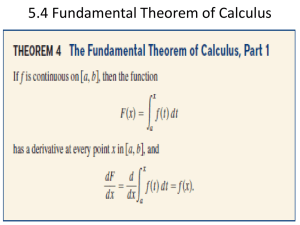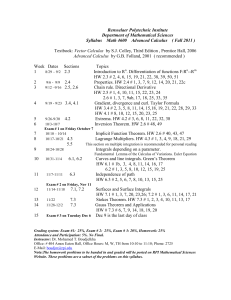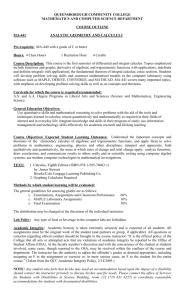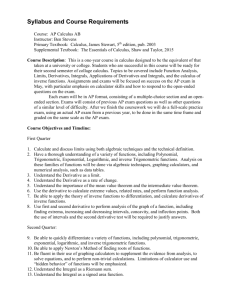AP Calculus AB Course Overview My main objective in teaching AP
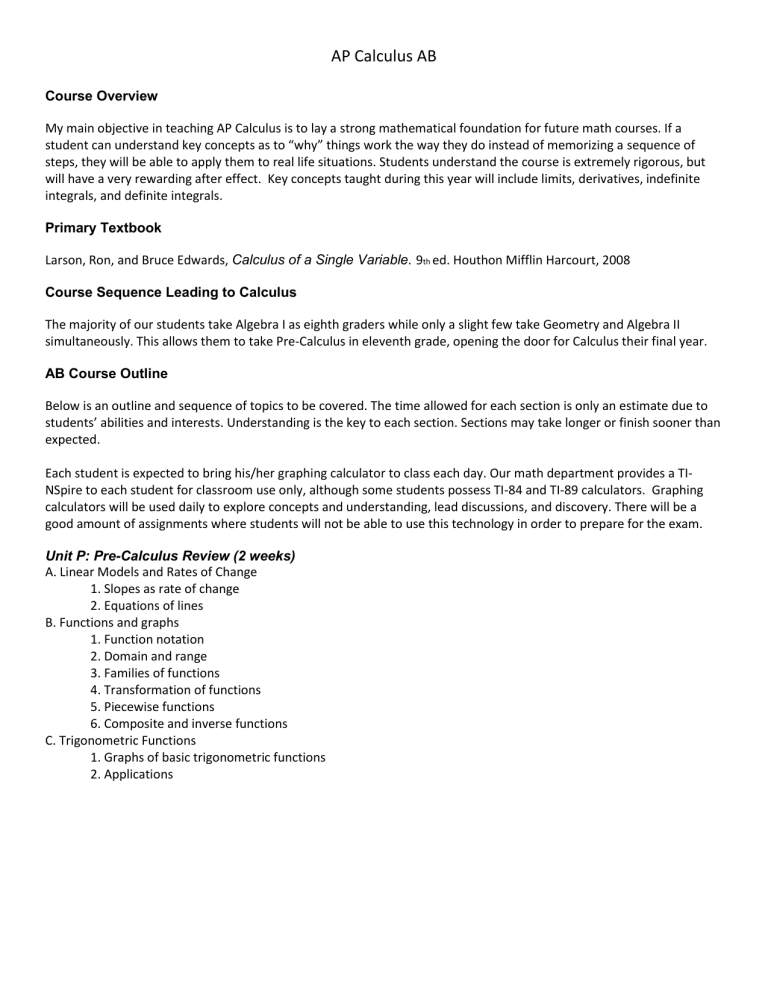
AP Calculus AB
Course Overview
My main objective in teaching AP Calculus is to lay a strong mathematical foundation for future math courses. If a student can understand key concepts as to “why” things work the way they do instead of memorizing a sequence of steps, they will be able to apply them to real life situations. Students understand the course is extremely rigorous, but will have a very rewarding after effect. Key concepts taught during this year will include limits, derivatives, indefinite integrals, and definite integrals.
Primary Textbook
Larson, Ron, and Bruce Edwards, Calculus of a Single Variable. 9 th ed. Houthon Mifflin Harcourt, 2008
Course Sequence Leading to Calculus
The majority of our students take Algebra I as eighth graders while only a slight few take Geometry and Algebra II simultaneously. This allows them to take Pre-Calculus in eleventh grade, opening the door for Calculus their final year.
AB Course Outline
Below is an outline and sequence of topics to be covered. The time allowed for each section is only an estimate due to students’ abilities and interests. Understanding is the key to each section. Sections may take longer or finish sooner than expected.
Each student is expected to bring his/her graphing calculator to class each day. Our math department provides a TI-
NSpire to each student for classroom use only, although some students possess TI-84 and TI-89 calculators. Graphing calculators will be used daily to explore concepts and understanding, lead discussions, and discovery. There will be a good amount of assignments where students will not be able to use this technology in order to prepare for the exam.
Unit P: Pre-Calculus Review (2 weeks)
A. Linear Models and Rates of Change
1. Slopes as rate of change
2. Equations of lines
B. Functions and graphs
1. Function notation
2. Domain and range
3. Families of functions
4. Transformation of functions
5. Piecewise functions
6. Composite and inverse functions
C. Trigonometric Functions
1. Graphs of basic trigonometric functions
2. Applications
Unit 1: Limits and Their Properties (3 weeks)
A. Finding Limits Graphically and Numerically
1. Introduction to limits
2. Two-sided
3. One-sided
B. Evaluating Limits Analytically
1. Properties of Limits
2. Limits of Trigonometric Functions
3. Limit Techniques a. Diving out b. Rationalizing c. Squeeze Theorem
C. Continuity
1. Continuous functions
2. Discontinuous functions a. Removable Discontinuity b. Jump Discontinuity c. Infinite Discontinuity
D. Limits Involving Infinity
1. Asymptotic behavior
2. Properties of limits
3. End behavior
Unit 2: Differentiation (5 weeks)
A. Definition of the derivative
B. Derivative rules and rates of change
1. Power rule
2. Product rule
3. Quotient rule
4. Trigonometric functions
C. Applications to velocity and acceleration
D. The chain rule
E. Implicit differentiation
F. Derivatives of inverse trigonometric functions
G. Derivatives of logarithmic and exponential functions
Unit 3: Applications of Differentiation (4 weeks)
A. Extrema on an Interval
1. Local extrema
2. Absolute extrema
B. Using the derivative
1. Rolle’s theorem
2. Mean value theorem
C. Increasing and decreasing functions and the first derivative
D. Concavity and the second derivative test
E. Curve Sketching
F. Optimization Problems
Unit 4-6: Integration (6-7 weeks)
A. Approximating areas
1. Riemann sums
2. Trapezoidal Rule
3. Definite integrals
B. The Fundamental Theorem of Calculus (part 1)
1. Average Value Theorem
C. The Fundamental Theorem of Calculus (part 2)
D. Antiderivatives
E. Separable differential equations
1. Growth and Decay
2. Slope fields
3. General differential equations
Unit 7: Applications of Integration (3 weeks)
A. Summing rates of change
B. Particle motion
C. Areas in the plane
D. Volumes
1. Cross sections
2. The Disk Method
3. The Shell Method
The remaining 4-6 weeks are made available to review for the AP Exam
Student assignments, quizzes, and exams
The year will be focused around student discovery and less lecture. Students will be encouraged to explore the internet for resources that explore different strategies to approach problems. Groups, not to exceed four students, will be assigned to encouraged help and create mentors.
Homework assignments will cover current topics mixed with past concepts to ensure constant review. There will be a 10 minute period at the beginning of class for students to get together to discuss homework from previous day. The last 10 minutes of class will be designated for question about their assignments.
Exams will occur approximately every 3 weeks as prompted by school’s testing schedule. Review will begin 3 days prior with an after school review session the day before. This is to ensure all questions have been answered with appropriate time.
Quizzes will be focused on misconceptions being presented in class in order to better prepare for exams
Note: All assignments, quizzes and exams can be re-taken as mandated by school’s redo policy. Student will receive an average of the old and new grade.
In preparation of the AP exam, students will have “AP Problems” due each week beginning midyear. These will be free response and graded on a 9pt scale. Students are encouraged to help one another and seek out any additional help that may be requiring, with the exception of myself. Students may not copy from another person’s work. The focus of these assignments is not only to understand concepts, but how to effectively communicate to AP readers.

